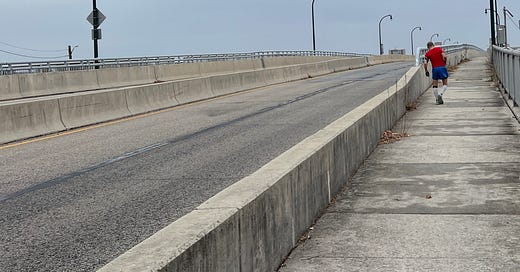He just ran his 398th marathon. Yet I was one of only five people to witness it.
In Other News // 2
Several weeks ago, I had the opportunity to serve as a bike marshal for a local marathon. Everyone who completes the marathon distance of 26.2 miles is a hero in my eyes. Yet, that day, I met a truly unsung hero whose tale deserves to be told.
Far removed from the flash and glitz of the elite frontrunners, he was in the unlikeliest of places—the very last runner within a race field comprised of hundreds of runners, each one covering the distance of 26.2 miles in their own way; each of their stories powering their steps. I was lucky that my path crossed with his that day.
If you’re a runner, you likely know about bike marshals. But chances are, you haven’t run near one in a race. And if you’re not a runner, you might be confused at the mention of bikers within a running event.
Either way, there’s a beautiful meaning behind the role of bike marshals, so allow me to start there and explain.
First, there are two types of bike marshals: leaders and sweepers. Those who lead a race and those who ride their bikes at the very end. You can think of them as the bookends of a marathon. And their roles, appropriately, are polar opposites.
Poised for the sound of the starting gun, lead bikers quickly guide the fastest elite runners along the course, often clearing the way of pedestrians and spectators by announcing, “Lead runners coming through; stay back!” Their job is to provide runners with a clear course, therefore ensuring the safety of the runners. Lead bikers must memorize each and every twist and turn in the race course, serving as guides for the eventual race winners over 26.2 miles. Talk about a thrill!
Serving as counterpoints, the race-concluding bike marshals are known as “sweepers,” who clear the course in the opposite way. It’s their duty to latch onto the final runners, often stragglers at the tail end of the race field, ensuring their safety in several ways—not only by riding nearby and marking the end of the race, but by assessing whether they need medical attention.
Along the marathon route, there are many volunteers manning water and aid stations—and it’s the sweepers who close out these stations by thanking and dismissing them, as the final runners go through. Periodically, sweepers also notify marathon organizers, EMS, police and highway workers of the final racers’ location—via a group text—so that streets can be reopened to traffic, volunteers can pick up tables, coolers, mile markers and other supplies, and so that EMS crews can be roaming, shadowing the final runners nearby.
I feel blessed to have had the ability to run three marathons, and it’s been my great honor to have served as a bike marshal for three others—as a sweeper.
All three experiences have introduced me to slower runners who—in my opinion—are just as brave, gutsy and hard-working as the decorated and heralded fast runners who break finish line ribbons and secure their places on the podium.
But perhaps my most recent experience takes the cake.



